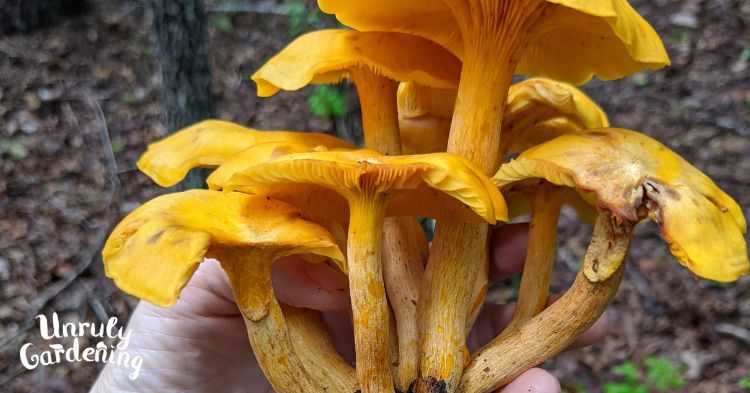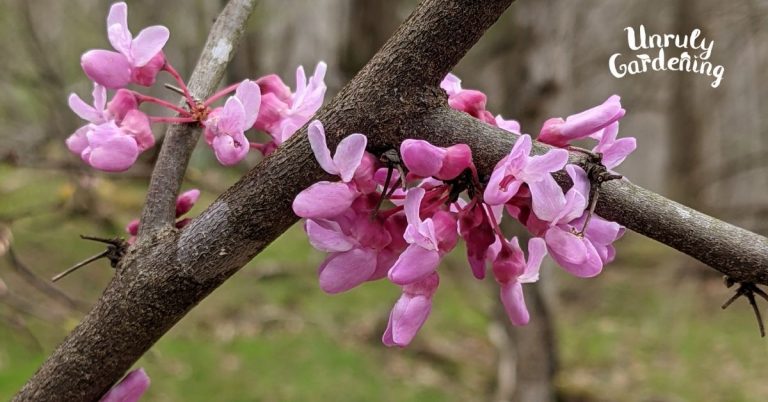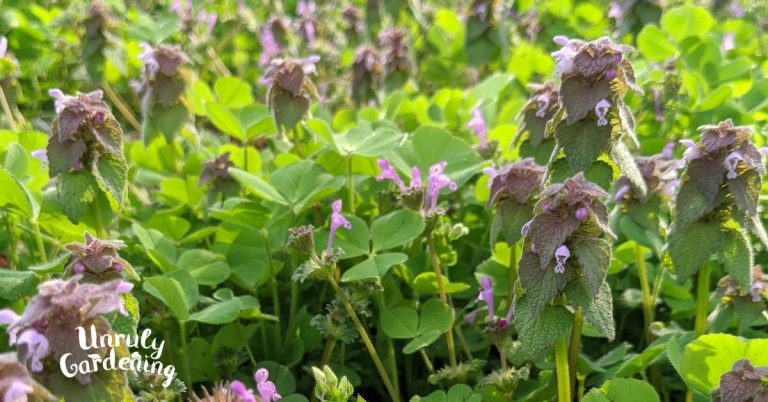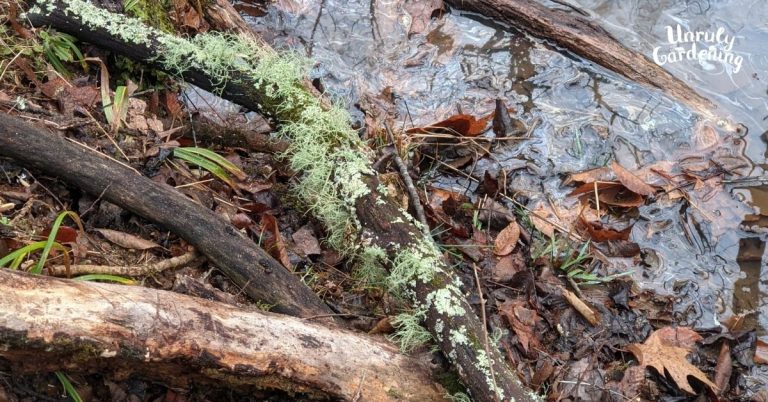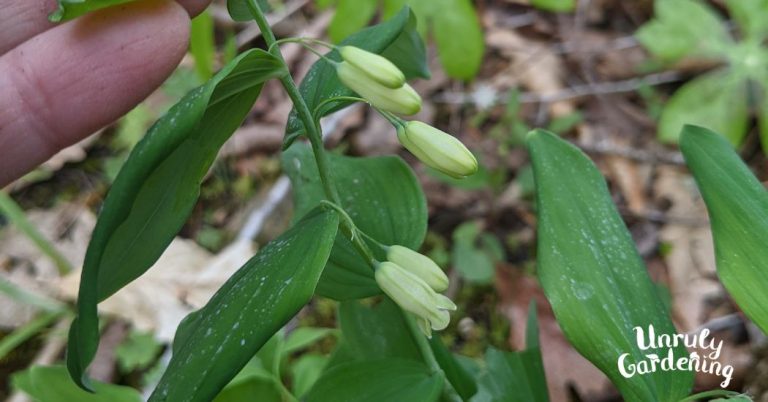Foraging Chanterelle Mushrooms
Learn how to find and forage chanterelle mushrooms, plus tips on harvesting, identifying lookalikes, and how to store and cook these prized wild mushrooms!

Hot and humid summer weather + lots of rain = tons of chanterelles popping up in our woods!
Because of their bright color, they’re fairly easy to spot, if you look in the right places.
There are several varieties of chanterelles (all in the family Cantharellaceae) growing in the United States and they don’t all look identical, but they do share characteristics that should help you more easily identify the ones growing near you.

Chanterelles are often called a perfect beginner forager mushroom, but I have to slightly disagree with the majority. I think they’re a little more challenging than other beginner friendly mushrooms like chicken of the woods, morels, or black trumpet mushrooms.
Once you find one, it can be easy to find more. However, it can be tricky for a newbie to discern the difference between “false gills” (ridges) and true gills (at least it was for me at the time!), and chanterelles have a look-a-like that can make you feel very sick (Jack O’ Lanterns).
For this reason, I suggest spending a lot of time reading articles, watching foraging videos, looking at other people’s mushroom photos in good Facebook mushroom groups, and going out in the woods exploring (but not eating) every yellow or orange mushroom you can find. All the better if you can find a local and more experienced mushroom hunter to help you find your first chants!

Above all else, don’t eat a mushroom that you’re not completely certain about and make sure to receive ID verification from several sources.
Some links on this site are affiliate links. That means we’ll earn a small commission if you make a purchase after clicking on one.


Tips for Beginner Foragers
In this article, you’ll learn the basics of foraging chanterelles (sometimes called “chants”), but be sure to also invest in some guidebooks for your area, and get second opinions from more experienced foragers.
Some of our favorite mushroom foraging books include:
- Mushrooms of the Southeast by Todd F. Elliott & Steven L. Stephenson
- How to Forage for Mushrooms Without Dying by Frank Hyman
- Appalachian Mushrooms: A Field Guide by Walter E. Sturgeon
- Mushrooming with Confidence by Alexander Schwab
The most important tip I can share is that if you have any doubt at all about the ID of any foraged plant or mushroom, don’t eat it!
What I suggest for chanterelles is to take lots of hikes and walks in nature during the year and thoroughly check out every orange or yellow mushroom you stumble across. Pick one from the ground, smell it, examine it from all sides, tear it apart and see if the stalks are hollow or solid, take one home to make a spore print… just don’t eat it until you’re 1000% sure of its identity.
It’s okay to just observe and examine mushrooms for learning purposes over many months, or even years, without eating them!

Where Chanterelles Grow
Chanterelles most often grow in deciduous woods with hardwood trees, though in some areas they’re found in pine groves or near other conifers.
They grow in harmony with trees – even though you can’t see it, there’s a whole mycorrhizal (underground fungal) network tied into the trees that chanterelles are growing nearby. For this reason, they’re not commercially grown, so be sure to enjoy their limited availability while in season!

The chants we find here at home mostly grow around oak trees, but you can also find them near tulip poplar, hickory, and beech trees. We’ll find the occasional scattering growing near pines, but there’s always an oak in the mix!
Look for areas where water runs off of hillsides, near creeks, or wooded slopes. You won’t find chanterelles right in the middle of a prairie, meadow, or hay field – they require that fungal network (symbiotic relationship) with trees, so there will be some kind of tree(s) nearby.
Once you find a chanterelle spot (or “honey hole”) then you can visit it year after year after year for fairly reliable harvests. Occasionally, a good spot might take a year off, or produce very little (usually dry weather related), but don’t despair too soon – there’s a high chance that they’ll return as normal the next year!

Yellow Jackets + Chants
Unfortunately, chanterelle season and yellow jacket nest season overlap! It never fails that at least once or twice per season, we stir up a yellow jackets nest while foraging for chanterelles and other peak summer mushrooms.
As you scour the ground for mushrooms, keep your eyes peeled for holes in the ground with these yellow and black striped wasps flying in and out. They like to make nests in leaf litter, near brush piles, and on creek banks. As long as you don’t step on the hole/nest itself, and give the area a wide berth, they won’t bother you. But, if you’re unlucky enough to step on one, be prepared for angry yellow jackets and stings!
For this reason, it’s a good idea to carry some Benadryl in your foraging kit. You can also mash up a plantain leaf by rubbing it between your fingers until it’s juicy (or chew it for a “spit poultice”) and then apply it to the stings until you can get home and treat them.

Tips for Identifying Chanterelles
Chanterelle mushrooms grow from the ground (dirt) – sometimes by themselves, or sometimes in small groups or clusters. You’ll find them growing in leaf litter, bare dirt, or mossy spots.
If you’re a beginner mushroom forager, keep in mind that you should only gather chanterelles growing from the ground. Brush leaf litter away and make sure there isn’t a hidden piece of wood or root that they’re growing from.
If a chanterelle-resembling mushroom is growing from wood, don’t eat it.
Chanterelle season starts around the last week of June for us here in North America on the east coast in USDA zone 7a, but peaks and gets really exciting in July and into August! (West coast folks may have a later fall season.)

Caps & Colors of Chanterelles
The color of chanterelle mushrooms usually range between orange and yellow. They’re often described as egg-yolk colored. The colors tend to “pop” or stand out brighter after a good rain.
The caps, or upper outside surface, are more flat when young, but as a chanterelle ages, it becomes more vase-shaped or funnel-shaped.

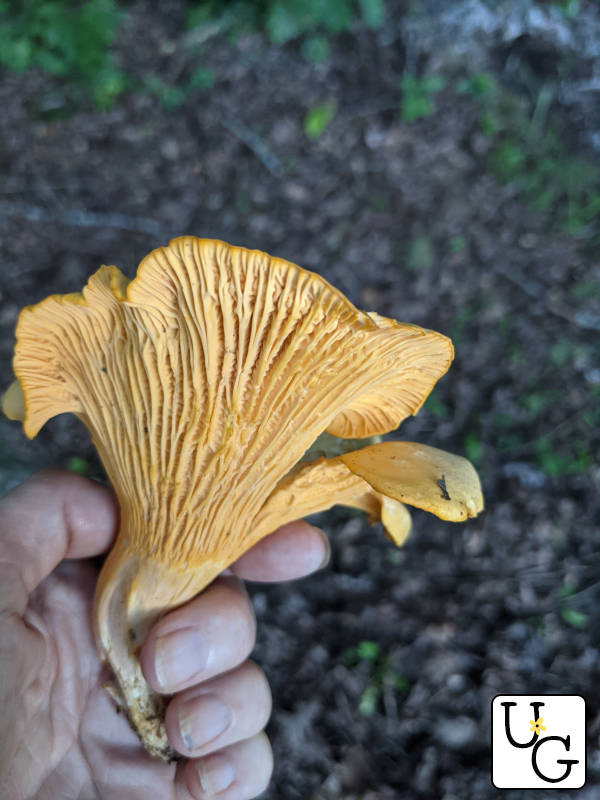
Underneath (Fertile Surface)
If you flip a chanterelle mushroom upside down, you’ll notice vein-like ridges on the fertile surface (which is the bottom part underneath where the spores are produced.)
For some chants, these thickened ridges or “false gills” on the underside will be very pronounced. Others, like the smooth chanterelle, may be mostly smooth or have light, but noticeable wrinkles.

The ridges or veins will fork and fuse and can have some irregularities. They’re pretty sturdy and almost rubber-like when you rub your finger over them.

In contrast, true gills are like delicate individual pleats you can run your finger along. I think of them like running my finger along pleated blinds or a piece of paper that’s been folded like a fan.
Chanterelles don’t have true gills.
Visual Difference Between “False Gills” and “True Gills”
Gills and ridges can be very confusing to tell apart at first! But keep looking and comparing different mushrooms that you find and you’ll eventually be able to start spotting the differences.
Here’s a side view of a chanterelle mushroom. To make it, I just took some scissors and cut a strip across the mushroom top.
See how the ridges (“false gills”) are wavy?

In contrast, below is a picture of a mushroom with gills. As you can see, they’re much longer and straighter.
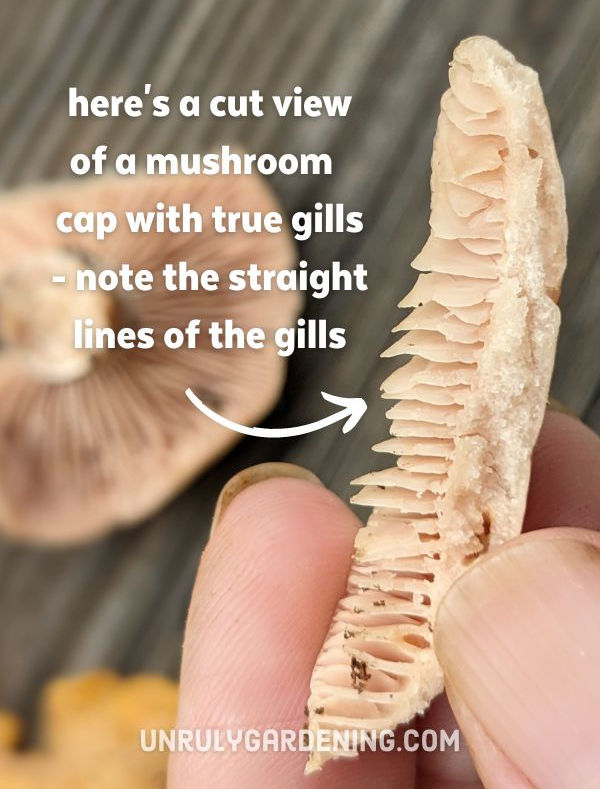
If you’re not sure if your mushroom has gills or ridges, try cutting off a strip of it as I did above and observe if you see rounded waves or bumps, or long straight lines.
Spore Print Example
The color of spore prints can range from white to creamy to yellow orange and even pinkish.

To make a spore print, cut the stem off your mushroom and lay it flat on a piece of paper or aluminum foil. Cover with a glass and let it sit overnight. Carefully pull up the glass the next morning and observe the spore print.
There’s a key you can use to help you hone in on identifying your type of chanterelle, found over at the Mushroom Expert website.
Chanterelle Stems
The stem of chanterelles is fleshy (not hollow) and you shouldn’t see any rings on the stem.
One commonly used way to ensure you have a chanterelle is to tear the stem open. It should be white inside and resemble string cheese.

If you slice the stem with a knife, it should be solid. (Or might be solid other than some bug damage in the stem.)

Of course, there are exceptions! Yellowfoot Chanterelles have a hollow stem. We don’t have those growing around here for me to comment on, but you can read more about those at Forager Chef.

How Chanterelles Smell
It’s often said that chants smell like apricots, but to be honest, I have collected many chanterelles and can rarely detect much apricot scent – only if my basket is very full at the peak of the season.
My husband can readily smell apricots, but my nose thinks that most chanterelles initially smell like a cross between putty and playdough.
However, I also can’t detect the hint of cucumber when sniffing pheasant’s back mushroom, so there is clearly a disconnect somewhere in my olfactory system and brain! 🙂
I’m not alone though; I’ve spoken to a couple of other experienced foragers who also can’t smell the apricot scent.

So all that to say – don’t immediately worry if your suspected chanterelle doesn’t have an apricot scent, you may be a member of the small club of us who just can’t detect that particular smell. Or, you may have a variety with less of a pronounced scent.
But you will have to be extra careful making sure the other identifying features line up. (And, as always, get second and third opinions if you’re a newbie forager!)
Chanterelle Lookalikes
When you first start looking for chanterelles, you may discover a lot of other mushrooms that might resemble what you’re looking for.
The main one to be aware of is Jack O’ Lantern mushroom, because it’s toxic and will make you extremely ill if you eat it. However, it has gills and other differences that we’ll cover below.
Once you find your first chants though and get a first hand look at its ridges (instead of gills), it’ll be so much easier to tell them apart from look-alikes in the future!

Gerronema strombodes
This little yellow mushroom tripped me up when I was first trying to identify chanterelles! It has the funnel shape, but it has true gills (which chants don’t have) and it grows directly from wood (which chants won’t do).
You’ll find it growing on dead oaks or other hardwoods.

Jack O’ Lantern Mushroom (Omphalotus illudens)
These bright orange mushrooms are definitely ones to pay attention to! Sometimes they’re confused with chanterelles, while other times people confuse them with chicken of the woods.
The thing is – jacks have distinctive gills, which you won’t find on chanterelles (because they have ridges or “false gills”) or on chicken of the woods (since they are a polypore with no gills.)
Jack-O-Lantern mushrooms (Omphalotus illudens) also grow in clusters and always on wood, very often found right around dead stumps. They’re an important part of the ecosystem, helping to break down dead trees. However, for people, they’re associated with severe gastrointestinal distress – they make you feel very sick if you eat them!
(I’ve also written an entire article all about identifying jack o lantern mushrooms – be sure to check it out for even more ID information!)

Another thing to note is that the inside of the Jack-o-lantern mushroom stem is yellow-orange (not white) and it doesn’t look like string cheese if you pull it apart.
When fresh, jack o’ lantern mushrooms even glow in the dark! However, it’s not like the glow in the dark stickers or toys we’re all familiar with. Putting the mushroom under a bright light for a while isn’t going to make it glow more. Instead, you have to take a fresh sample into the darkest room in your house. Then wait, and wait, and wait. Eventually, your eyes will adjust and you’ll be able to see a very dim, greenish glow!

False Chanterelles & Lactarius/Lactifluus
Quite a few other mushrooms might be mistaken for chanterelles.
These include milk cap mushrooms in the Lactarius and Lactifluus families, or false chanterelles (Hygrophoropsis aurantiaca).
Just keep in mind that chanterelles do not have gills, and that chants have solid stems with white flesh (that look like string cheese if you break them open) and that will help you sort out these tricksters!
Milky caps also exude a white liquid or “milk”, hence their name. Chanterelles do not have white liquid oozing from them.

Another Yellow/Orange Mushroom to Know….
Though it doesn’t really look like chanterelles, another yellow/orange mushroom to mention is chicken of the woods!

You may spot these tasty mushrooms while foraging for chanterelles – just know that they’re edible too!
We have a whole in-depth article that will help you learn more about foraging for Chicken of the Woods:
Identifying Chicken of the Woods Mushroom

How to Harvest Chanterelles
There’s a bit of debate whether you should pull chanterelles from the ground, or cut them at the surface.
A study in 2006 demonstrated that it doesn’t really matter.
What does matter is that you don’t want to bring any of that dirt home with you! So if you pull the mushroom from the ground, be sure to use a knife and trim off the bottom piece with dirt on it before putting it with the others you collect. If you have a good mushroom knife with a brush (like my Opinel knife shown in some of these photos) then you can easily brush loose dirt off.
It’s a good idea to leave behind any mushrooms that have a lot of dirt or sand stuck all over them. They’ll be kind of a pain to clean and might get your other mushrooms all dirty in the bag or basket.
Good foraging etiquette is to never pick an area clean whether you’re on private or public land. Other critters besides you will enjoy eating those mushrooms, no need to take them all!

Cleaning Chanterelles
It’s easy enough to clean chanterelles, especially if you were very careful when harvesting. Right before you plan on preparing your mushrooms, give them a brief rinse in a colander under cold water, then dab them dry with a clean dish towel.
Some foragers like to soak their chanterelles in salt water in case there’s any insects inside. I don’t worry about that because I don’t want my ‘shrooms to get all water logged!
Also, let’s be honest – we’re dealing with uncultivated wild mushrooms here and we’re not going to avoid unknowingly eating a bug or two along the way. I’m okay with that, but definitely do what makes you feel comfy, whether it’s soaking in salt water or a quick rinse.
I like to tear each chant in half or multiple pieces as I’m washing to make sure the stem looks like string cheese – this helps me know I didn’t accidentally pick something non-chanterelle in the gathering frenzy. And it also lets me check for bug damage inside the stems.

How to Store Chanterelles
The trusty brown paper bag method of storing most mushrooms works great for chanterelles too!
Keep your freshly harvested chants in a brown paper lunch bag in the fridge for up to a couple of days. Before folding the bag closed, place a damp paper towel inside, over the mushrooms.
Ideally, you’ll want to cook them the same day or the next day for optimum freshness. You can brush off loose dirt beforehand, but don’t wash with water until right before you’re ready to cook them.
Chanterelles can stay in the refrigerator for a few days, but the less time they’re in storage, the better they’ll be.
You can also sauté and freeze the cooked mushrooms once they’ve cooled. Raw chanterelles don’t freeze so well.
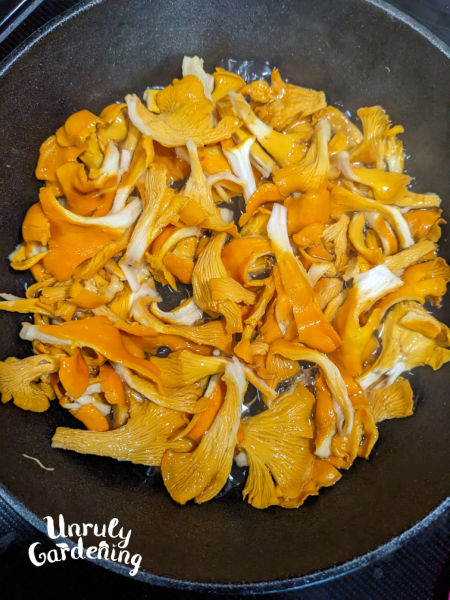
Chanterelle Cooking Tips
Like most mushrooms, you should not eat chanterelles raw – they should always be cooked.
Chanterelles have a mild taste that’s almost buttery. It’s a very delicious flavor, even when prepared simply.
Because of their high water content, chanterelles are often dry cooked before adding oil, butter, and seasonings.
To do this, just place your freshly rinsed (or very cleanly picked) chants in a completely empty frying pan. (No oil or butter added, yet.) Heat up the pan with the mushrooms in it and stir them frequently over medium heat until the chanterelles have released their liquid and most of it has evaporated off. This will only take about 2 to 4 minutes, depending on burner heat level and pan type.
THEN you can add butter, olive oil, garlic, onions, shallots, salt, pepper, herbs, white wine, vinegar, etc. for flavoring and cook a while longer until they’re tender.
We like ours really simple, with just some butter, garlic and/or onion, and maybe a splash of balsamic vinegar. They’re especially tasty spooned over a steak, but many creative cooks have invented other delicious-looking chanterelle recipes you can find online.
Chanterelles and black trumpets go together splendidly too! More about those here:
Foraging Black Trumpet Mushrooms
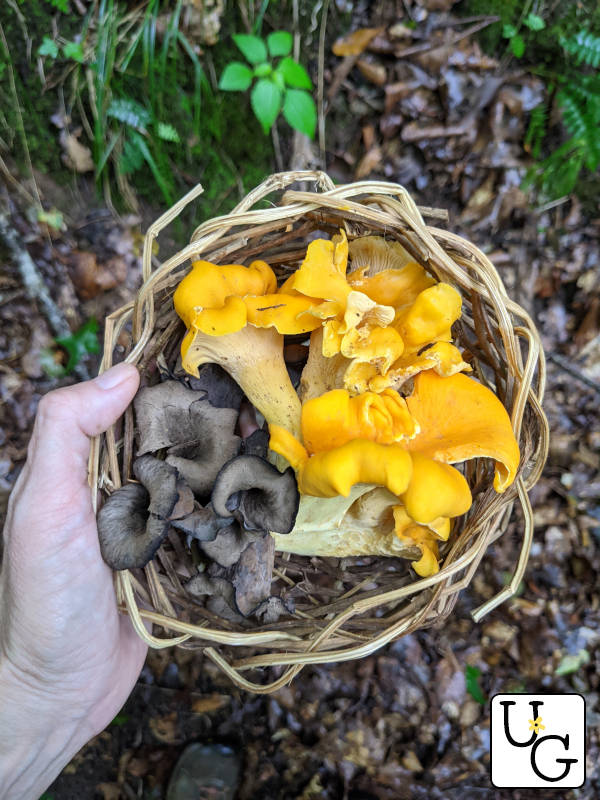

More Mushrooms to Look For
Here are more of our mushroom articles you might enjoy reading:
- Foraging & Using Reishi Mushrooms
- Identifying Chicken of the Woods Mushroom
- Foraging Black Trumpet Mushrooms
- 12 Tips for Foraging Morel Mushrooms
Our articles are for information and idea-sharing only. While we aim for 100% accuracy, it is solely up to the reader to provide proper identification. Be sure to seek out local foraging classes and plant walks, and invest in foraging guides suitable for the area you live in, since some wild foods may have adverse effect.

